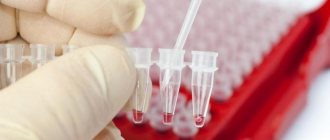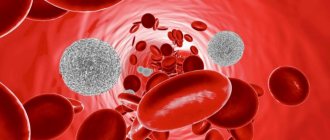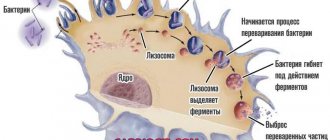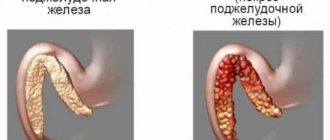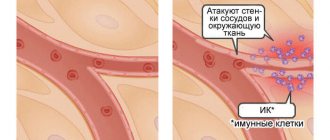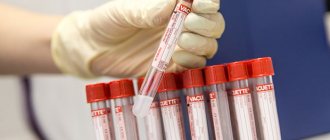Hemoglobin is a special blood protein found in red blood cells. Performs a vital function. Thanks to it, cells and tissues are saturated with oxygen, and gases and substances are exchanged in the body. Therefore, the importance of hemoglobin cannot be overestimated. If its level drops, health problems occur. This could be due to various reasons. So it is necessary to maintain a normal protein level and know ways to restore it.
What is hemoglobin
Hemoglobin is a protein found in red blood cells. This element acts as a connecting link in metabolism, as it transports oxygen to all internal structures of the body and removes carbon dioxide from them. In addition to helping tissues “breathe,” the protein performs a pigment function, in other words, it gives the blood fluid a red tint.
Fluctuations in the required level of hemoglobin in the blood may indicate a pathological or some kind of stressful condition.
If any changes in the amount of hemoglobin are detected, patients are sent for additional studies, which help to reconstruct a complete clinical picture, and also allow one to diagnose/refute the presence of possible diseases.
Table of hemoglobin norms in the blood of women by age
Women experience many different hormonal changes throughout their lives, which are treated by an endocrinologist. They may be associated with physical overexertion, frequent stress, pregnancy, menstruation or menopause. For these reasons, enzyme concentrations may vary throughout the month and do not indicate the presence of any pathological processes in the body. In addition, depending on the age of the patient, protein levels will also vary.
Nowadays you can find a lot of information on the Internet regarding the norms of various blood parameters, including hemoglobin. The figures indicated there are far from the real situation. The medical guidelines used by doctors indicate clear ranges - the minimum and maximum of each indicator. There is "from and to" for all ages. To treat the patient and determine the further prognosis. For hemoglobin, both the upper and lower limits of normal are important
The standard hemoglobin level in women varies from 120 to 150 g/l. You can evaluate the results of the analyzes by checking the indicated values with the tabular data.
Hemoglobin norm in women - table by age:
| Woman's age | Hemoglobin norm, g/l. |
| 17 — 20 | 120 — 150 |
| 21 — 30 | 120 — 150 |
| 31 — 40 | 120 — 145 |
| 41 — 50 | 120 — 140 |
| 51 — 60 | 120 — 140 |
| 61 — 65 | 120 — 140 |
| more than 65 | 120 — 150 |
Normal hemoglobin level in women aged 30–40 years
The norm at 40 years is at its highest level, after which it gradually begins to decline. Such modifications are associated with hormonal changes in the body that begin to occur during this period. The process of minimizing the concentration of the enzyme in the blood continues throughout subsequent years. Compared to thirty-year-old women, at 40 years old the protein content decreases by 5 g/l.
Normal after 50 years
After 50 years, the norm of hemoglobin in the blood of women decreases noticeably . These modifications can be clearly seen in the table; the indicated indicators do not correspond to normal values. Such disorders are associated with hormonal and emotional instability. Women at this age are susceptible to depression, various experiences) and quickly get tired even with minimal physical exertion (the help of a psychologist can help cope with such conditions.
Normal for women after 60
As indicated in the table, the hemoglobin level in women after 60 years of age becomes critical. This situation is associated with the end of menopausal changes and the minimization of metabolic processes in the body. Hemoglobin in women after 65 years of age has critical indicators, as internal metabolism in tissues slows down.
Leukocytes
Leukocytes are a large group of diverse cells whose task is to provide protection to the body. In international medicine, they are often referred to as WBC - white blood cells. This abbreviation denotes the total content of leukocytes in the analyzer form. The reason for the increase in WBC is various damaging factors: infections, injuries, ischemia and tissue necrosis, and others. Simply put, an increase in the number of white blood cells means that the immune system is actively involved in the fight against damage. At the same time, low values of the indicator may indicate a lack of immunity under the influence of radiation, medications, certain viral infections, as well as diseases that are accompanied by impaired formation or increased destruction of leukocytes.
Leukocyte indices
In addition, in assessing the content of leukocytes, leukocyte indices , or in old forms - leukocyte formula . The general clinical analysis with the latter is called detailed. There are several types of leukocytes, which differ from each other in morphology and functional characteristics. The leukocyte formula reflects their percentage of the total number, and modern analyzers also display the absolute content of each type of these cells. They can be identified on the form by the following abbreviations:
- LYM - lymphocytes;
- MXD - agranulocytes (monocytes, basophils and eosinophils);
- NEUT—neutrophils;
- MON - monocytes;
- EO - eosinophils;
- BA - basophils.
If there is a “%” sign after the abbreviation, then we are talking about percentage, and the “#” sign means their absolute content. Changes in the leukocyte formula can serve as an indicator of a wide variety of problems in the body. Let's take a closer look at them.
The main task of neutrophils is phagocytosis - the absorption of foreign objects and their destruction. They always rush to areas of inflammation and tissue breakdown, where they perform this work, so their increased content indicates active inflammation.
In addition to neutrophils, the function of phagocytosis is performed by macrophages, into which, in the process of their development, monocytes . A high level of the latter also serves as a marker of inflammation, usually of an infectious nature.
Eosinophils take part in reactions associated with the allergic component. An increase in their number is observed in allergies, parasitic infestations, some infections and cancer.
Basophils take part in inflammation and allergies by releasing heparin, histamine and serotonin. They rarely increase in isolation, although such a phenomenon in some forms of leukemia has a serious prognostic significance.
Lymphocytes are actively involved in a wide variety of conditions, including immunodeficiencies, allergies, inflammation, and autoimmune disorders. Their high content may be a sign of childhood infections, viral hepatitis, mononucleosis, tuberculosis and a number of other diseases.
Assessment of leukocyte indices and leukocyte formula requires an understanding of the pathological and physiological processes in the body, and should not be carried out solely on the basis of tabular data. You absolutely cannot diagnose yourself based solely on the results of the analysis.
Table of hemoglobin norms in men by age
In men, the concentration of hemoglobin in the blood differs significantly from the normal values of the enzyme in women. So, in the male half, its content should not decrease to 130 g/l. and rise above the level of 170 g/l.
Such differences are associated with the production of testosterone in men, which can further enrich blood cells with oxygen.
In addition, the energy costs of the stronger sex are larger, which means the need for air exchange increases.
The norm of hemoglobin in the blood of men, depending on age, is shown in the table:
| Age | Normal hemoglobin g/l. |
| 15 — 18 | 120 — 155 |
| 18 — 30 | 130 — 170 |
| 30 — 40 | 130 — 155 |
| 40 — 60 | 130 — 160 |
The hemoglobin level in men after 30 years gradually begins to decrease. These differences can be analyzed using the table. Such changes are directly related to testosterone production.
As you know, after 40 years, the production of the hormone decreases, and therefore, male libido is gradually suppressed (consultation with a sexologist can solve this problem)
Against the background of ongoing processes, the physical activity of a man is similarly minimized.
In men after 50–60 years, the concentration of the enzyme is minimized, since testosterone virtually ceases to be produced. Therefore, it is regularly necessary to monitor the indicators of blood components and undergo tests. Any deviation from normal values (as indicated in the table) should be immediately eliminated, since at this age there is a high risk of developing anemia and other pathologies associated with the abnormal composition of the blood fluid.
Causes of anemia
Common causes of low hemoglobin are:
- large blood loss;
- disruption of the formation of new blood cells;
- activation of pathological processes of blood destruction.
Causes of posthemorrhagic anemia
Acute posthemorrhagic anemia is the result of the loss of a large amount of blood in a minimal period of time. The chronic form of this disease is caused by:
- prolonged blood loss;
- polyps, hernias and stomach ulcers;
- kidney diseases;
- malignant tumor neoplasms;
- uterine bleeding;
- disorders of the blood clotting system;
- liver failure, cirrhosis.
What causes hemolytic anemia
All hemolytic anemias occur if “old” red blood cells begin to destroy faster than new ones can form.
The sickle cell form is caused by the synthesis of a defective hemoglobin molecule. The emerging defective molecules form peculiar crystals that stretch the red blood cell, causing the latter to take on the shape of a sickle. Sickle erythrocytes are non-plastic. It leads to increased blood viscosity and blockage of small blood vessels. With their sharp ends they can destroy each other.
Thalassemia is a hereditary disease. It occurs due to a decrease in the rate of hemoglobin formation. Hemoglobin that is not fully formed is unstable. It resembles small inclusions that give the red blood cell the appearance of a target cell.
Deficiency anemias and their causes
Iron deficiency anemia develops for reasons such as:
- lack of iron/increased need for iron (this is why degree 1 anemia is often diagnosed in premature babies and pregnant women);
- chronic blood loss;
- problems associated with the absorption of iron from the gastrointestinal tract, its transportation and disposal.
B12 deficiency anemia is caused by a lack of vitamin B12. The disease can be caused by poor nutrition (refusal to eat meat) or disruption of the absorption of cyanocobalamin in the gastrointestinal tract (parasites, diseases of the small intestine, stomach). Also, symptoms of B12 deficiency anemia can appear while taking hormonal drugs and anticonvulsants.
Folate deficiency anemia is a consequence of a lack of vitamin B9. It is usually observed in pregnant and lactating women, cancer patients, teenage children, premature newborns, liver disease, alcohol abuse, etc.
Causes of hypoplastic anemia
Hypoplastic anemia is manifested by a decrease in the content of all cells in the blood. External and internal factors lead to such a pathological and life-threatening condition:
- vibration and radiation effects on the body;
- serious injuries;
- taking certain medications;
- ingestion of poisons into the body;
- herpes, fungi, bacteria;
- genetic mutations;
- rheumatoid arthritis, lack of elements involved in hematopoietic processes;
- endocrine diseases, etc.
Table of hemoglobin norms in children by age
In newborns, the density of hemoglobin in the blood has maximum values. Then its content gradually decreases, a certain stability of indicators appears only at 6 months. This condition persists until the child reaches 5 years of age, after which the concentration of the enzyme begins to increase again.
It is also worth considering that when a child reaches the age of 12 years, it is necessary to analyze protein indicators based on his gender. They will be different for boys and girls.
The norm of hemoglobin in the blood of children by age is shown in the table:
| Age | Boys | Girls |
| from 0 to 15 days. | 160 — 200 | 160 — 200 |
| 1 - 3 months | 120 — 160 | 120 — 160 |
| 4 - 6 months | 95 — 140 | 95 — 140 |
| 6 – 12 months | 110 — 145 | 114 — 150 |
| 1 - 2 g. | 110 — 130 | 110 — 130 |
| 2 - 5 l. | 105 — 150 | 105 — 145 |
| 5 - 11 l. | 110 — 140 | 110 — 140 |
| 12 - 14 l. | 120 — 140 | 120 — 140 |
| 15 - 17 l. | 120 — 155 | 120 — 150 |
Interpretation and normal values of the main blood test parameters
| How is it designated? | What does it mean | Norm for women | Norm for men |
| R.B.C. | Red blood cells | 3,5-4,5 | 4,0-5,5 |
| WBC | Leukocytes | 4-9 | |
| PLT | Platelets | 180-320 | |
| HGB | Hemoglobin | 120-140 | 130-170 |
| MCV | Average erythrocyte volume | 82-98 | 81-95 |
| MCH | Average HGB level in erythrocyte | 26-32 | |
| MCHC | Average concentration of red blood cells in HGB (%) | 31-38 | |
| HCT | Hematocrit (in%) | 35-44 | 40-50 |
| RET | Reticulocytes (%) | 0,2-1 | |
| ESR | ESR (mm/h) | 2-15 | 1-10 |
| CPU | Color | 0,85-1,05 | |
Normal hemoglobin level in blood during pregnancy
During pregnancy, a woman’s amount of enzyme in her blood will differ from the values indicated in the table above. Also, pregnant women should know what medications can and cannot be taken during pregnancy. These deviations are associated with various changes that occur in the body.
Approximate indicators of enzyme content in pregnant women are shown in the table:
| Trimester | Amount of hemoglobin g/l. |
| 1 | 115 — 165 |
| 2 | 110 — 145 |
| 3 | 110 — 140 |
These differences are associated with the end of menstruation and the subsequent growth of the placenta, which requires constant nutrition. Therefore, it is important for the expectant mother to systematically undergo blood tests, since a critical decrease/increase in hemoglobin can become a source of dangerous complications (hypoxia, abnormal fetal development, early birth, underweight of the baby, retardation in mental/physical development, etc.).
Doctor's advice
Often the cause of increased hemoglobin is non-compliance with the drinking regime. The body receives little fluid (less than 1.5-2 liters of clean water per day, tea, coffee and other liquids do not count), this causes the blood to thicken. In this condition, not only hemoglobin, but other indicators also increase - hematocrit, red blood cells, platelets. Hematologists advise that if you have anemia, your diet should focus on meat. Liver and buckwheat are in second place in importance. Next are apples, nuts, cocoa. These same principles apply not only to adults, but also to children.
Victoria Druzhikina Neurologist, Therapist
Symptoms of anemia
Conventionally, the symptoms of low hemoglobin are classified into:
- specific (manifest only in specific types of anemia);
- nonspecific (the same for all types of disease).
Nonspecific symptoms of anemia are as follows:
- pallor of the skin/mucous membranes;
- migraine;
- increased fatigue;
- noise in ears;
- refusal of food;
- constant drowsiness;
- feeling of lack of air;
- dizziness;
- cardiopalmus;
- decreased libido, sexual impotence in men;
- disruption of the menstrual cycle;
- heart failure.
Specific signs of different types of anemia
Each type of anemia has its own specific symptoms. Thus, the acute posthemorrhagic form manifests itself:
- increased heart rate;
- fainting;
- cold sweat;
- attacks of dizziness;
- pale skin;
- decrease in body temperature.
In chronic posthemorrhagic anemia the following are observed:
- very white skin;
- craving for or intolerance to certain smells;
- swelling of the face;
- change in taste sensations;
- dry skin;
- brittle nails;
- nausea;
- lack of air;
- sweating;
- involuntary urination when sneezing or laughing;
- temperature increase.
Hemolytic anemias are characterized by:
- yellowness of the skin and mucous membranes (when red blood cells are destroyed, bilirubin enters the bloodstream);
- increased size of the spleen/liver;
- increased levels of bilirubin in the blood;
- darkening of urine and feces;
- high body temperature;
- weakness.
Sickle cell anemia - a type of hemolytic - has the following symptoms:
- jaundice;
- shortness of breath;
- formation of inflamed areas on the legs;
- blurred vision;
- the presence of hemoglobin in the urine.
Doctors diagnose thalassemia if the patient:
- the shape of the skull bones changes;
- the skin becomes very pale with a yellowish/greenish tint;
- eyes become narrow and swollen;
- there is a lag in mental/physical development;
- bones are deformed;
- the spleen/liver enlarges.
Signs of iron deficiency anemia include:
- buzzing in the head;
- lack of oxygen;
- migraine;
- constant desire to sleep, rest;
- dry skin;
- peeling of nails;
- hair section;
- desire to eat chalk, smell paint, etc.;
- violation of the act of urination;
- hyperhidrosis.
Also, during laboratory tests, it is discovered that the level of hemoglobin and red blood cells in the blood is significantly lower than the established norm.
B12 deficiency anemia affects the gastrointestinal tract and central nervous system. As a result, the patient experiences:
- swelling of the legs;
- crawling sensation on the arms/legs;
- change in gait;
- memory impairment;
- problems swallowing food;
- enlarged liver/spleen;
- drying of the gastrointestinal mucosa.
In turn, folate deficiency anemia manifests itself:
- inability to eat acidic foods;
- glossitis;
- difficulty chewing and swallowing food;
- enlarged spleen/liver;
- atrophy of the mucous membranes of the gastrointestinal tract.
The symptoms of hypoplastic anemia are:
- the appearance of ulcers in the mouth, on the skin of the face;
- bruising on the skin;
- severe bleeding gums;
- increased fatigue;
- desire to sleep;
- tachycardia;
- decrease in the number of leukocytes, red blood cells and platelets in a blood test.
If you experience similar symptoms, consult your doctor
. It is easier to prevent a disease than to deal with the consequences.
Hemoglobin level in women during menstruation
During the menstrual period, protein content decreases sharply. This feature of the female body is associated with loss of blood fluid and is not a sign of pathology. It is for this reason that women feel unstable during menstruation:
- dizziness occurs (about other causes of dizziness here);
- appetite increases;
- there is a persistent feeling of fatigue, etc.
At the same time, experts recommend refraining from taking blood tests a few days before/after menstruation, as the information will be distorted. The normal level of hemoglobin after menstruation is restored within 2 – 3 days (with correct nutrition and lifestyle).
Platelets
The main task of platelets is to participate in stopping bleeding. They form the primary plug in the area of vessel damage and participate in the formation of a blood clot. In forms, automatic analyzers are designated by the abbreviation PLT , which comes from the English word platelets (literally, “saucers”) for their peculiar shape.
A decrease in the number of platelets can be accompanied by bleeding and is a consequence of diseases and conditions such as malaria, thrombocytopenic purpura, malignant neoplasms, disseminated intravascular coagulation syndrome and some others.
A high platelet count can cause excessive blood clotting and often has no apparent cause. In this case, the condition is designated as essential thrombocythemia. In addition, thrombocytosis can be caused by iron deficiency anemia, hemolysis, some infectious and autoimmune diseases, and bone marrow damage.
This is where the work with platelets in a classic blood test ends; however, automatic analyzers even in this case offer additional diagnostic capabilities in the form of the following indicators:
- MPV —mean platelet volume. An indicator reflecting the size of cells, which directly depends on their age. An increased MPV may indicate hematological diseases, damage to the spleen, thyrotoxicosis, and progression of atherosclerosis. A decrease in the rate is observed in some genetic diseases, myocardial infarction, childhood infections, cancer chemotherapy and a number of other conditions.
- PCT is the ratio of the total volume of platelets to blood plasma (thrombocrit). It is not a specific indicator, it varies widely physiologically, but it allows one to assess the risk of bleeding and thrombosis.
- PDW —platelet distribution by volume. The indicator has no independent meaning and is assessed in conjunction with other indices.
Causes and symptoms of low hemoglobin
Iron deficiency anemia is a fairly dangerous and common condition in which the blood cell content is less than the lower limit of normal.
In this case, the patient may have the following symptoms:
- vertigo;
- severe fatigue;
- change in taste preferences;
- frequent headaches (read how to get rid of headaches in this article);
- dyspnea;
- decreased blood pressure;
- decreased muscle tone;
- brittle nails/hair.
The danger of decreasing hemoglobin levels is that the brain and other internal structures do not receive the required amount of oxygen, and therefore cease to function correctly. As a result, associated health problems appear that significantly affect the quality of life.
The main reasons for a decrease in hemoglobin in the blood:
- poor nutrition (frequent diets, lack of vitamins, etc.);
- chronic gastritis (here you can find effective tablets for stomach pain)
- chronic pyelonephritis;
- arthritis;
- hepatitis;
- dysbacteriosis;
- tuberculosis;
- blood loss (after operations, injuries).
What are the consequences if low hemoglobin is not treated?
Oxygen delivered by hemoglobin ensures the normal functioning of all organs. If it is not enough, then functional and organic changes begin, resulting in a life-threatening condition. The degree of damage depends on the duration of oxygen starvation, and the consequences lead to the formation of a number of pathologies:
- painful changes in the liver;
- development of shortness of breath;
- the appearance of pathological changes in the vascular and cardiac systems;
- disruptions in the functioning of the nervous structure;
- changes in the composition of the blood, a decrease in red blood cells - anemia;
- development of atherosclerosis;
- exacerbation of chronic diseases.
A slight decrease in hemoglobin relative to the norm is associated with weakness and increased fatigue. As the gap in indicators increases, a depressive state and irritability appear.
Note! A large lack of hemoglobin in pregnant women is fraught with premature birth and the development of hypoxia in the unborn child.
How to increase hemoglobin in the blood
It is important to control the ratio of all components of the blood fluid. Since its minimization is a pathological condition that will require certain treatment, and it does not always go away quickly and successfully. As therapy, doctors can take measures such as:
- blood transfusion (used in extreme cases, when the level is greatly reduced and drug treatment fails);
- prescription of vitamins (B9 and B12);
- taking iron-containing medications (in the form of tablets, suspensions or injections);
- drawing up a special menu (iron-enriched foods are added to the diet - meat, liver, herbs, vegetables, buckwheat, dried fruits, seafood, chocolate, etc.)
Therapy to increase hemoglobin levels in the blood is prescribed by a doctor during a personal appointment or online consultation. You can consult online or consult with a service doctor.
Iron is different from iron
It is believed that the best way to increase hemoglobin levels is to eat more foods containing iron. Old folk recipes advise: cook liver dishes, eat carrots, beets, walnuts, apples, drink pomegranate juice, and you will quickly increase hemoglobin.
Actually this is not true. Because iron is different. Indeed, many fruits and vegetables and legumes contain a lot of iron, but it is poorly absorbed. As well as from the liver, where iron compounds are presented in the form of complex proteins that are not easy for the body to “take away”. The so-called heme iron, found only in meat and poultry, is best absorbed.
But in order for it to be absorbed, it is also important what the meat is eaten with. For example, if you serve pasta or porridge as a side dish, much less iron will be absorbed: cereals contain phytates that bind it. An excellent partner for meat dishes are vegetable side dishes made from zucchini, broccoli, onions, and herbs (they contain substances that stimulate hematopoiesis). It makes it difficult to absorb iron and calcium, so dairy and meat products are not compatible.
Fats inhibit hematopoiesis, so fatty meats and fish, and especially lard, are excluded. But butter and any vegetable oil - sunflower, olive, corn, pumpkin, etc. - should definitely be on your table. Do not drink tea immediately after meals - tannin binds iron, preventing it from being absorbed. And don’t get too carried away with coffee - this drink “washes” iron from the body.
Vitamins, especially C, help the absorption of iron. It is useful to drink orange and tomato juices every day. And eat more fruits and vegetables: the best suppliers of ascorbic acid are black currants, citrus fruits, kiwi, and bell peppers. In winter, when the vitamin C content in fresh fruits and vegetables drops sharply, sauerkraut and rosehip infusion perfectly replenish it.
High hemoglobin: causes, treatment
If hemoglobin levels in the blood exceed the norm indicated in the table, then this condition is also a reason to consult a doctor. In this case, the patient may have symptoms such as:
- problems in the functioning of the genitourinary system;
- drowsiness;
- yellowish skin;
- poor appetite;
- decreased vision;
- oncology;
- chronic heart failure;
- high fatigue.
The reasons for such a violation include:
- diabetes mellitus (the disease is treated by an endocrinologist);
- increased blood viscosity;
- erythrocytosis;
- excess vitamin B12/B9;
- chronic obstructive pulmonary diseases.
Frequently asked questions and doctor's answer
General practitioner Victoria Druzhikina answered questions
1. What is Hemoglobin indicated in a blood test?
- “In a general blood test, hemoglobin is abbreviated as Hb, measured in grams per liter.” 2. Why is low Hemoglobin dangerous?
– “Low hemoglobin levels are dangerous due to anemia and its consequences:
- oxygen starvation of organs and tissues, primarily nervous;
- muscle weakness;
- fainting due to decreased blood pressure;
- decreased immunity;
- wear and tear of the heart muscle due to the development of compensatory tachycardia in conditions of lack of oxygen;
- heart attacks;
- retardation in mental and physical development.
In severe cases, untreated anemia can lead to hypoxic coma and death due to brain or heart failure.”
3. Blood transfusion for low hemoglobin
– “To treat severe forms of anemia, blood or red blood cell transfusions are used. The procedure is indicated in 2 cases:
1. With a hemoglobin level of 70 g/l and below.
2. In case of poor tolerance to anemia and the threat of hypoxic coma at any level of hemoglobin. This can occur in people whose lives involve high oxygen consumption - pregnant women, athletes, scuba divers playing wind instruments.
The standard regimen is 2 doses (1 dose – 200 ml) twice a week. Before and after the procedure, general urine and blood tests and temperature must be monitored.
Before the manipulation, the patient’s blood type and Rh factor are determined, and donor blood is selected based on these indicators. Next, the compatibility of the blood samples is checked. If the reaction proceeds normally, a transfusion is performed. If flakes or clots form, this blood is not transfused, but other samples are tested for compatibility.” 4. Hemoglobin norm in children under one year old
– “The hemoglobin norm in children under one year of age is determined by physiological factors. By the end of the 1st month, the numbers are higher than in adults and amount to 160–200 g/l.”
5. How to increase Hemoglobin in a child?
“If anemia is detected, it is important to increase hemoglobin levels as soon as possible, especially in children. The main role in this belongs to drugs. Unfortunately, nutrition will not significantly increase the numbers. With the help of food, you can only slightly improve your performance and maintain it at this level.
Foods to increase hemoglobin in children:
- beef;
- buckwheat;
- cocoa;
- liver;
- apples;
- pomegranate;
- walnuts.
Drugs for the treatment of anemia in children:
- Maltofer;
- Ferrum Lek;
- Totema;
- Ferlatum and others"
6. How to increase hemoglobin during pregnancy?
“During pregnancy, it can be difficult for a woman to follow a diet with foods rich in iron. However, their list is quite wide, you can choose what you like:
- beef;
- wheat bran;
- hazelnuts;
- cabbage, including broccoli;
- chocolate;
- rabbit;
- liver;
- cocoa;
- apples;
- pears;
- parmesan, etc.
How to increase hemoglobin during pregnancy - the most used drugs:
- Maltofer;
- Sorbifer Durules;
- Ferrum Lek;
- Gyno-tardiferon;
- Totema;
- Ferlatum and others."
7. Iron supplements to increase hemoglobin in adults
– “To treat anemia in adults, the same drugs are used as for pregnant women. Can also be used:
- Venofer;
- Ferlatum protein;
- Cosmopher;
- vitamin complexes with iron (Ferro-Folgamma, Fenyuls, etc.).”
8. Normal Hemoglobin in Newborns? – “The hemoglobin norm varies slightly from month to month, the generally accepted average values are 120–160 g/l.
Immediately after birth, the mother’s blood circulates in the baby, so values from 180 to 240 g/l are considered normal for the 1st week of life.”
For information on hemoglobin levels, see also the video:
This article has been verified by a current qualified physician, Victoria Druzhikina, and can be considered a reliable source of information for site users.
Bibliography
1. The norms of indicators are indicated in Appendix No. 3 of Order of the Ministry of Health of the Russian Federation dated 09/14/2001 364 (as amended on 06/06/2008)
Rate how useful article
4.7 was. 30 people voted, average rating 4.7
Did you like the article? Save it to your wall so you don’t lose it!
In letter and in spirit
If, during repeated blood tests, hemoglobin remains at the same level or continues to decrease, it is necessary to switch to iron supplements. For children, they are available in the form of dragees, capsules, syrups (there are also solutions for injections). For adults – in tablets and injections. There are monocomponent preparations - that is, those that contain only iron (they are usually prescribed to those who suffer from allergies) and combined ones, where iron is combined with various vitamins that promote its better absorption.
The doctor may prescribe injections in cases where the absorption of iron in the intestines is severely impaired (with inflammatory bowel diseases, severe diarrhea).
But in our country, as a rule, preference is given to tablets. Because, on the one hand, iron “in the injection” is absorbed worse, on the other (paradox!) – you can overdo it with its dosage. Which is also not good. Because iron, once it enters the body, is not removed from it itself, but lies in the so-called “depots”. Excess iron storage can trigger the development of diabetes, severe liver disease, heart disease, and even breast cancer.



